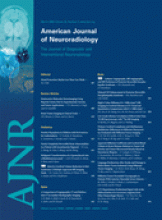Japanese encephalitis (JE) is usually a monophasic disease characterized by fever, altered sensorium with or without seizures, and other focal neurologic symptoms. If the patient survives, there is gradual recovery with or without persistent signs of central nervous system (CNS) injury. MR imaging helps in establishing an early diagnosis and shows lesions in the thalami, substantia nigra, basal ganglia, hippocampi, cerebral cortex, brain stem, and cerebellum. A biphasic form of JE has been reported, with early relapse of symptoms within days or a few weeks after recovery from the first phase. To our knowledge, this is the only report in literature of biphasic JE.1 We report the MR imaging findings of a patient with JE and biphasic illness.
A 16-year-old boy presented to our institute with a history of fever, headache, body ache, and occasional vomiting for 14 days and altered sensorium for a day before admission. On examination, he had meningeal irritation, spasticity, mutism, tremors, and perioral dyskinesia. Findings of routine blood examination were normal. CSF examination results showed lymphocytic pleocytosis and raised protein. CSF immunoglobulin capture enzyme-linked immunosorbent assay (MAC-ELISA) result was 250 U, establishing a diagnosis of JE. MR imaging showed T2-hyperintense and mildly T1-hypointense lesions in both thalami (Fig 1A) and substantia nigra. On treatment, there was gradual recovery, and the patient was discharged a week later.
Twenty-five days later he was readmitted with a history of low-grade fever, headache, and vomiting for 3 days and altered sensorium for 1 day. He had signs of meningeal irritation, limb spasticity, hypokinesia, tremors, perioral dyskinesia, and behavioral changes in the form of a violent agitational state. CSF examination was repeated on days 47 and 62 after the onset of the first phase. There was mild increase in cells, mainly lymphocytes and protein on day 47, with normal cells and raised protein on day 62. CSF MAC-ELISA results were 247 and 261 U, respectively. On MR imaging, fresh lesions resembling the acute lesions seen earlier were now noted in both basal ganglia. The earlier noted thalamic and substantia nigra lesions had partially resolved (Fig 1B). He recovered gradually with treatment and had completely recovered without any deficit on follow-up in 3 months.
Biphasic JE is characterized by early relapse of meningoencephalitic symptoms, which may be somewhat different from those of the first phase but still conform to known features of JE. Patients usually recover well. MR imaging shows fresh JE lesions in the second phase, in addition to JE lesions in the first.1 Our patient showed similar clinical and imaging features. Lesions in the substantia nigra and thalami were seen on MR imaging in the first phase, followed by fresh lesions in the basal ganglia in the second phase, all known sites of involvement of JE. Behavioral changes and extrapyramidal features were more prominent in the second phase in comparison with the first. Our patient also showed good recovery. Biphasic JE is not common in our experience, and this is the only case we saw among 87 consecutive confirmed cases of JE in the last 7 years.
Persistence of the JE virus (JEV) in the CNS is suggested by the raised JEV-specific immunoglobulin M (IgM) levels in the CSF in our patient. Detection of JEV-specific IgM in the CSF long after the acute phase of the illness has been considered as immunologic evidence of virus persistence in the CNS.2 Whether persistence of JEV may be the reason for the biphasic illness in our patient is obscure. Alteration in the host immune mechanisms and a unique strain of JEV have been implicated. The former is a more likely mechanism because reactivation of latent JE infection has been experimentally demonstrated in immunologic-poor states.3
In conclusion, JE may rarely present as a biphasic illness. MR imaging shows typical JE lesions in the first phase, with fresh areas of involvement in the second phase.
A, Axial T2-weighted MR image obtained in the first phase (day 17 of onset of JE) of the disease shows bilateral thalamic lesions (arrows). Substantia nigra lesions were also seen at this stage (not shown). B, Axial T2-weighted MR image obtained in the second phase (45 days after onset of first phase) shows fresh lesions in the basal ganglia (arrows). Residual lesions (arrowheads) are noted in the thalami. These have partially resolved. Residual lesions were also seen in the substantia nigra at this stage (not shown).
- Copyright © American Society of Neuroradiology













